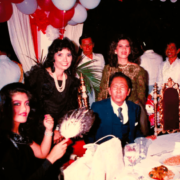Something odd was happening.
Faced with popular protest and revolt in the army, President Marcos left Malacañang Palace in a US Airforce Huey helicopter on the evening of February 25, 1986.
Camp Crame was the center of army revolt.
I wish I could remember it all better, without weakening the adequacy or vitality of the narrative.
Where the vegetable garden had been, there now lays a lawn. And the sculpture garden, too. All the concrete statues were being smashed and carried away. The workers watched us, as we passed. There were tanks by every gate, like huge mechanical monsters. The security check was very much in operation.
Walking down to center of the road to the Palace, our feet crunching broken glass stones, we pleaded like children to soldiers with an M-16 to let us proceed…we were warned there were a few Marcos loyalists hiding in side streets, even as the fighting had stopped.
Within the view of the Palace, I saw people climbing over the railings, pouring into the gates and jostling expostulatory with excess zeal.
The gates flew open, and we blended with the immense concourse of people of all sexes, age and character; with a lot of coming and going in the different buildings.
Inside the compound, documents were flying out of the offices, as the crowd rejoiced. It was a strange mixture — some looked seraphically happy, my colleagues said they felt like victorious insurrectionists.
Then, an armed civilian sent by the rebel troops bellowed — we couldn’t go any further.
But it was too exciting. An AP photographer went past the guard, then another photographer followed and then another one.
Inside the private chambers of the Marcoses, it was strikingly beautiful.
Precious goods of every kind surpassed everything I have ever seen before: paintings of the masters, statues, tapestry, Russian giant vases, Venetian chandeliers, monogrammed towels (with the initials of Mrs. Marcos), Aubisson bed sheets and fine china in an open crater, with jade plates so large and vulgar.
Then we went into the ceremonial hall, where proposed chimeral schemes of the Marcos era were hatched. There was a lot of coming and going.
People ran and sat on the strongman’s throne, giving a mock press conference, issuing orders in that deep baritone voice, falling about with laughter or just gawking at the splendor of the hall that was fully lit.
The Blue Drawing Room was impossible to describe or indeed to conceive. You gaze and words fail. There was this huge magnificent library. The other journalists gazed in wonder at the leather-bound gold-gilded volumes and collection of art books. This was the reference library of Mrs. Marcos — a renowned collection of treasures.
We’ve never seen anything of such splendor. No one hardly dared touch the furniture and trinkets.
There was the most exquisite marvelous grand piano Van Cliburn played, and I couldn’t resist playing Mendelssohn’s On Wings of Song.
My colleagues had obviously hoped for something more racy, or lofty and patriotic like the Internationale or Bayan Ko.
What was hard to believe was the whole Press Corps was there but the Marcoses weren’t.
A soldier came in, brandishing an Uzi and ordering us to “please cooperate.” So we did.
Outside, the awe had consumed itself into the crowd.
As they stood by the fountain, they looked down at the colored lights beneath the Pasig River, not saying anything.
Now, they are a crowd of a happy cheerful world — transitioning from contempt and fury of the populace to the affectionate transport admiration and glory of the present.
Today, there were fireworks. The whole country celebrated.







